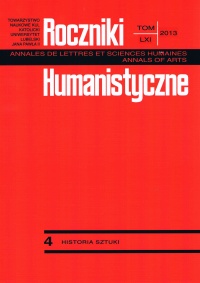The plaque with the representation of Mary with the Infant in the Holy Trinity Church in Strzelno – “the Stone Icon”
Abstract
Among the numerous monuments of the Romanesque sculpture surviving in the two post-Norbertine churches in Strzelno, Kujawy, there is a relief, rectangular, sandstone plaque, closed by a semicircle, that used to be called a „votive plaque”. It shows Mary with the Infant Surrounded by the Prophets (105x62 cm). Now it is kept in the Muzeum Roman´skiego Os´rodka Kultury Ottona i Bolesawa (Museum of the Romanesque Center of the Culture of Otto and Bolesaw) attached to the Holy Trinity Church in Strzelno.
The decoration of the plaque is a combination of inspirations coming from the monuments of Western and Eastern art. In the way some of the elements are presented similarity may be seen to other old Strzelno sculptures created by the same workshop of the West European origin (Saxony, Lombardy). On the other hand, the manner of presenting the whole allows counting the Mary with the Infant plaque among the presentations of Hodegetria, and Byzantine ivory plaques reaching West Europe could have provided inspiration for it. Considering their connections with Strzelno, that are becoming ever more certain, Piotr Wostowic and his wife Maria, a Ruthenian princess, were the guiding spirits for this form of the image. This also strengthens the thesis concerning their daughter Beatrycze, who was the first magistra with the Strzelno Norbertine nuns, for whom the convent was built. Under these circumstances the gold sheet icon from Martvilla in Georgia (10th century) may be indicated as a possible source of inspiration for the Strzelno plaque. The presentations of the surrounding prophets are characterized by the same kind of commotion and „nervousness” that can be noticed in the Sages of the Apocalypse on the tympanum of the St Peter Church in Moissac (about 1130), but as far as the style is concerned they are closer to the stocky figures shown by the Lombardy master, Wiligelm. The original function of the plaque is not known. It seems that this representativesymbolical image must have performed a special task: e.g. it was a part of the altar, or a stone relief „imitation” of an alcove with a figure in it, serving as a cult object.
References
Вieniаk J.: Ród Łabędziów, w: Studia nad wspólnotami krewniaczymi i terytorialnymi w Polsce średniowiecznej, Toruń 1987.
Bieniek S.: Uwagi nad powstaniem klasztoru w Strzelnie i fundacjami Piotra Włostowica z około połowy XII wieku, „Prace Komisji Historii Bydgoskiego Towarzystwa Naukowego” 2(1964).
Braun J.: Der christliche Altar in seiner geschichtlichen Entwicklung, Bd 1: Arten, Bestandteile, Altargrab, Weihe, Symbolik; Der christliche Altar in seiner geschichtlichen Entwicklung, Bd 2: Die Ausstattung des Altars, Antependien, Velen, Leuchterbank, Stufen, Ciborium und Baldachin, Retabel, Reliquien- und Sakramentsaltar, Altarschranken, Miinchen, 1924.
Сetwiński М.: Rycerstwo śląskie do końca XIII w. Biogramy i rodowody, Wrocław-Warszawa-Kraków-Gdańsk-Łódź 1982.
Chudziakowa J.: Zespół architektury romańskiej w Strzelnie w świetle najnowszych badań, „Acta Universitatis Nicolai Copemici”, Archeologia 13(1990), z. 184, s. 5-27.
Ciećkiewicz Z.: Liczba w koncepcji ideowej romańskich kolumn w Strzelnie. Cztery żywioły, trzydzieści sześć dekanów, „Roczniki Humanistyczne” 52(2004), z. 4, s. 31-57.
Hewner K.: Próba identyfikacji wczesnośredniowiecznego warsztatu budowlanego ze Strzelna, NP 91(1999), s. 5-46.
Jazykowa I.: Świat ikony, tłum. z rosyjskiego ks. H. Paprocki, Warszawa 2007, s. 117-120.
Karczewski D.: Dzieje klasztoru norbertanek w Strzelnie do początku XVI wieku, Inowrocław 2001.
Kępiński Z.: Odkrycie w Strzelnie, „Biuletyn Historii Sztuki i Kultury” 8(1946), s. 202-207.
Markowska R. K.: Ikonografia cnót i przywar na kolumnach w Strzelnie, „Studia Źródłoznawcze” 26(1981), s. 79-111.
Onasch K., Schnieper A.: Ikony. Fakty i legendy, tłum. Z. Szanter, M. Smoliński, ks. H. Paprocki, Warszawa 2007.
Rajman J.: Norbertanie Polscy w XII wieku. Możni wobec Ordinis Novi, w: Społeczeństwo Polski średniowiecznej. Zbiór studiów, t. VII, red. Stefan K. Kuczyński, Warszawa 1996, s. 71-105.
Sielicki F.: Polsko-ruskie stosunki wyznaniowe w XI i XII wieku, w: Dzieło chrystianizacji Rusi Kijowskiej i jego konsekwencje w kulturze Europy, red. R. Łużny, Lublin 1988, s. 35-49.
Sikorski Cz.: O fundacji klasztoru norbertanek w Strzelnie, „Archaeologia Historica Polona” 1995, t. II, s. 193-209.
Sroka Z.: Romańskie kolumny figuralne w Strzelnie (Ikonografia), Gniezno 2000.
Sulkowska-Tuszyńska K.: Tajemnicza bazylika św. Trójcy w Strzelnie i jej ołtarze, „Z Otchłani Wieków” 57(2002), nr 1-2, s. 40-43.
Sulkowska-Tuszyńska K.: Klasztor norbertanek w Strzelnie (XII-XVI wiek). Sacrum inprofanum, Toruń 2006.
Szczęsna J.: The Architectural Sculpture in the Former Norbertine Churches in Wrocław-Ołbin and in Strzelno in Romanesque Period, „Analecta Praemonstratensia” 85(2009), s. 49-72.
Świechowski Z.: A jednak Hildegarda, RMNW 36(1992), s. 105-117.
Świechowski Z.: Architektura romańska w Polsce, t. I-II, Warszawa 2000.
Świechowski Z.: Die Figurensaulen der Klosterkirche in Strzelno und die Sachsische Plastik des 12 Jahrhunderts, „Kunstchronik” 19(1966), s. 312-313.
Świechowski Z.: Die figurierten Saulen von Strzelno, „Zeitschrift fur Kunsgeschichte” 30(1967), s. 273-308.
Świechowski Z.: Nieznane rzeźby romańskie w Strzelnie, „Acta Universitatis Nicolai Copernici”, Archeologia 13, Archeologia Architektury 1990, z. 184.
Świechowski Z.: Strzelno romańskie, w: Strzelno romańskie. Zbiór studiów, Strzelno 1972, s. 19-20.
Świechowski Z.: Strzelno. Rzeźba romańska, Strzelno 1987.
Świechowski Z.: Studia nad rzeźbą w Strzelnie, „Rocznik Historii Sztuki” 8(1970), s. 71-116.
Świechowski Z.: Sztuka romańska w Polsce, w: Dzieje sztuki w Polsce, t. I, Warszawa 1990.
Świechowski Z.: Romanizm, w: Sztuka Polska, t. I. Warszawa 2004.
Walicki М.: Dekoracja architektury i jej wystrój artystyczny, w: Sztuka polska przed- romańska i romańska do schyłku XIII wieku, t. I. red. M. Walicki, Warszawa 1971, s. 212-213.
Wirth K-A.: Elëusa, w: Reallexikon zur Deutschen Kunstgeschichte, Bd. 4, sp. 1297-1308.
Żurek A.: Maria Włostowicowa, w: Encyklopedia Wrocławia, red. J. Harasimowicz Wrocław 2000, s. 489.
Copyright (c) 2013 Roczniki Humanistyczne

This work is licensed under a Creative Commons Attribution-NonCommercial-NoDerivatives 4.0 International License.





